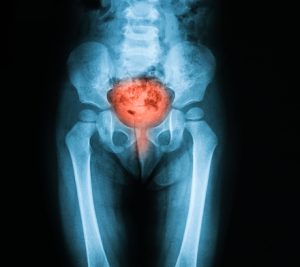
An enlarged urinary bladder may occur from birth, while other enlarged bladder causes are the result of an obstruction of some sort, most likely post-renal or in the bladder itself. This leads to an abnormally high volume of urine in the bladder that fails to empty as it normally would.
What causes an enlarged bladder?
The bladder is a muscular sac located in the pelvis above the pubis bone. When empty, it resembles the shape of a pear and is not visible from outside the body. However, if it were to become enlarged, it may protrude past its typical resting area, sitting outside its normal position. This can cause problems, as an enlarged bladder can impair the normal functions of other surrounding organs such as the kidneys.
Urinary obstruction in itself may be the cause of bladder wall thickening over time. When this occurs, the whole organ becomes larger than normal.
Chronic cases trouble urinating, where by the bladder becomes larger due to an abnormally large volume of urine output, can lead to an enlarged bladder. These people have trouble urinating and consistently retain a bit of urine. Conditions such as these restrict the bladder from shrinking down to normal size, leaving it stretched out.
Having an enlarged bladder is a relatively common condition. Infants can even be born with the condition, albeit rarely. When this occurs, the babies don’t necessarily suffer from any negative consequences at first, but may later in life. However, when an enlarged bladder is found to be present in a child, the first thing commonly done is make sure that no urinary obstruction or other health conditions need to be addressed. In cases of a non-interfering abnormality, the child can simply be monitored for the first several years of life.
Diabetes and obesity are two conditions that, when present together, are closely linked to an enlarged bladder. Obesity often precedes the development of diabetes, which makes weight management the best preventative management for reducing the risk of developing an enlarged bladder. However, if both obesity and diabetes are already present, getting down to a healthy weight and properly managing blood sugar levels will help avoid potentially serious health complications.
Kidney stones and tumors are the leading causes of urinary obstruction leading to an enlarged bladder over time. Prompt recognition of these conditions will help prevent the bladder from becoming over stretched.
There are certain medical conditions that lead to the inability to consciously empty the bladder on a regular basis. These are neurological problem which include multiple sclerosis and paralysis. Because of neurological damage preventing the travel of electrical signals to allow the bladder to release urine, the bladder becomes enlarged.
A condition called obstructive uropathy can lead to an enlarged bladder. It can be due to a number of different causes and results in either a partial or complete lack of urine flow. Urine may even flow backward into your kidneys, exposing you to even more complication and urinary tract damage.
Symptoms of an enlarged bladder
Physiologically, an enlarged bladder will present with common symptoms that can be seen in the majority of affected individuals. This may include the following:
- Slow urine flow
- Feeling the bladder is full constantly
- Difficulty urinating
- Possibly abdominal pain
- Urinary incontinence
- Nocturia—waking up to urinate at night
Considering there are a multitude of varying causes for enlarged bladder development, specific causes may present with unique urinary symptoms. Injuries causing a pelvic fracture will present with additional pain. Kidney stones will present with pain, difficulty urinating, and possible blood in the urine. Having a tumor mass that spreads to the kidneys signifies great carcinogenic issues.
The origin of the obstruction will also dictate the type of treatment used. For large masses such as cancerous tumors or kidney stones, surgery is an option. Getting the obstruction out will most likely relieve the issue. Placing a stent to keep open a narrow ureter or kidney can also promote flow. Treatment of unborn children in the womb involves the use of a shunt to drain the child’s bladder into the amniotic sac.
Related: Urinary bladder neck obstruction: Causes and treatments